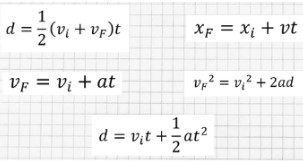Physics - Freefall / Projectile Motion / Kinematics
1/17
There's no tags or description
Looks like no tags are added yet.
Name | Mastery | Learn | Test | Matching | Spaced |
|---|
No study sessions yet.
18 Terms
Kinematics
It's the branch of classical mechanics that describes the motion of points, objects, and systems of groups of objects, without reference to the causes of motion.
“Motion in one direction”
Distance (d)
It is the total length of the path traveled by an object without any regard to direction.
It is a Scalar quantity because it is always POSITIVE.
d = speed x time
Displacement (Δx)
It refers to “How far out the place an object is”,
object’s overall change in position.
It is a Vector quantity because it can be POSITIVE or NEGATIVE, direction is important.
Δx = Final position-Initial position
Speed (s)
It refers to “How fast an object is moving” .
It can be thought of as the rate of which an object covers distance.
Scalar Quantity
s = distance/time
Velocity (v)
It is a displacement per unit of time and has a specific direction
it contains the direction as well as the magnitude of a moving object
the rate at which an object changes its position
Vector Quantity
v = displacement/time
Acceleration (a)
speed and direction
It is the rate of change of velocity with time.
It is a Vector quantity and can be calculated as the change in velocity divided by the time taken.
a = Δv/Δt.
9.8m/s²
Acceleration due to gravity formula?
Freefall
The idealized motion of a falling object which is acted upon only by the force of gravity
David Scott
Projectile Motion
Combination of uniform horizontal motion and free fall
Time and speed symmetries in the vertical component
Velocity (v)
Equation?

Acceleration (a)
Equation?

Displacement (Δx)
Equation?

Distance (d)
Equation?

Speed (s)
Equation?

Trajectory
curved path of a projectile
Derived Equations (remember)

Time Symmetry
The time required for the object to reach its maximum height equals the time for it to return to its starting point
Speed Symmetry
At any displacement above the point of release, the speed of the body during the upward trip equals the speed during the downward trip